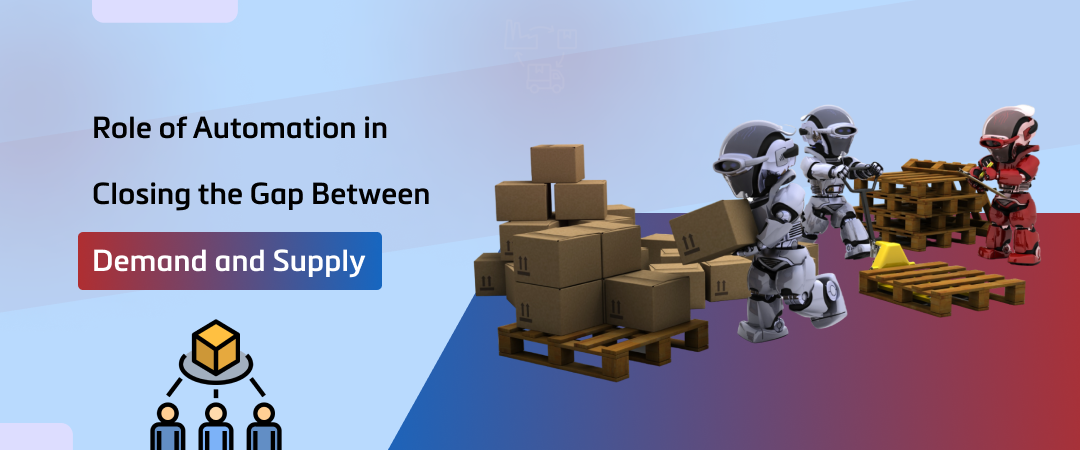
Role of Automation in Closing the Gap Between Demand and Supply in Logistics

The gap between demand and supply gaps makes it quite hard for logistics businesses to synchronize planning and scheduling goods across various logistics functions. With digital technologies like automation, logistics sectors can efficiently streamline their operations and stay competitive.
Each logistics function follows its own unique business model and factors to develop a logistics working plan. And as various functions in logistics execute the plans, it might lead to confusion that may disrupt bridging the gap between demand and supply in logistics.
Why This Gap Exist in Logistics?
Demand Forecasting Errors
The perfect demand forecasting plan must be created based on various aspects like past sales data, current market trends, and predictive analysis. But, when the forecasting is created with outdated or incomplete data, it fails to create impact in transforming logistics operation. For example, a sudden fall in top selling products may occur due to the sudden entry of new products in the market. It might result in surplus inventory or excessive wastages.
Issues in Inventory Management
Effective inventory management is essential to make sure that the right amount of stock will be available at the right time. Challenge arises when the inventory levels are not aligned along with the actual demand. Similarly, there are chances for stockouts if the demand exceeds supply. This results in a loss in sales and customer dissatisfaction.
Read more on how can automation prevent stockouts and excess inventory in logistics.
Trustworthiness of Supplier and Vendor
The reliability of supplier and vendor has a direct impact on logistics. Challenges that come with supplier reliability include scenarios like delays in delivery, quality issues, or financial constraints. Therefore, it is risky to depend on a single source of vendor as it will result in critical issues.
Market Dynamics
The market is dynamic. So, the demand prediction and forecast vary based on various factors like consumer preferences, competitiveness, and market trends. Other factors like sudden demand for new products, competitors’ new marketing approach, and the change in market trend also play a major part in predicting demand.
Wondering How Automation Works? Request a Free Demo | WhatsApp
Three Ways to Bridge the Gap Between Supply and Demand
Do you know what it takes to bridge the gap between supply and demand in logistics?
Here are a few ways automation can help your logistics business succeed.
1. Reimagine your workflow
It is essential to reinvent your workflows with various logistics functions. Is your organization spending too much time on working with manual invoices? You are not alone. Around 60% of logistics companies invest in automating their invoices processing in the next five years. If your company is manually monitoring workflows, it is time to consider automating the possible workflows which helps to save hours of billable time. In your logistics organization, you can consider automating operations like purchase order processing, invoice management, and expense management.
Examples of Logistics Automation:
- Order Processing and Placing
- Automated Supplier Communication
- Automated Customer Service
- Automated Inventory Replenishment
2. AI Algorithms for Accurate Forecasting
AI algorithms can help logistics companies to analyze sales data history, market trend analysis as well as accurately analyzing external factors. With predictive analytics, logistics companies can use statistical techniques and machine learning for forecasting the future demand based on historical data and market trends. Moreover, with AI-integration, logistics sectors can identify irregularities or deviations from expected demand patterns. This will alert the team to fix the potential issues such as unexpected spikes or drops in demand.
Example of AI Demand Forecasting
- Real-time data from their point-of-sale systems
- Machine learning algorithms to predict customer demand
- AI-powered anomaly detection for demand forecasting
- Automated data integration to consolidate data in real-time
3. Improvise the Quality of Reporting
Through automation’s advanced reporting and analytics features, logistics can effortlessly enhance the demand forecasting. By consolidating data from multiple sources in real-time, automation provides numerous data sets like sales transactions, inventory levels, customer interactions, and external factors like market trends or weather conditions. By integrating with existing business tools like ERP and CRM, automation helps logistics sectors to provide ample insights that influence decision making and predicting demands. Besides, it also helps to cluster similar demand patterns, trends, and customer behavior for specific area or region.
Examples of Automating Report Enhancing Demand Forecast:
- Real-Time Demand Insights
- Forecast Accuracy Reports
- Seasonal Trend Reports
- Supplier Performance Reports
As automation is evolving as the next big advancement in technology, logistics sectors are keen about making best use of automation. From providing inventory reports to tracking real-time demand, logistics automation plays a significant role in bridging the supply and demand gap in the logistics sector. But combining human touch with automation is important to create a perfect balance for innovation and success.
With iSQUARE’s Logistics Automation Software, you can improve your logistics demand forecasting effortlessly. Our customized logistics automation solution helps you efficiently optimize inventory levels and improve productivity of logistics operations. Interested in automating your logistics operations? Schedule a call with our team of experts!
Wondering How Automation Works? Request a Free Demo | WhatsApp














